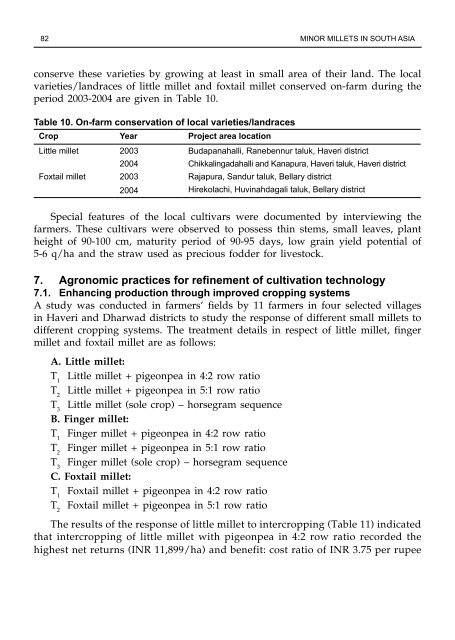Minor millets in South Asia: learnings from IFAD-NUS project in India ...
Minor millets in South Asia: learnings from IFAD-NUS project in India ...
Minor millets in South Asia: learnings from IFAD-NUS project in India ...
Create successful ePaper yourself
Turn your PDF publications into a flip-book with our unique Google optimized e-Paper software.
82 m<strong>in</strong>or <strong>millets</strong> <strong>in</strong> south asia<br />
conserve these varieties by grow<strong>in</strong>g at least <strong>in</strong> small area of their land. The local<br />
varieties/landraces of little millet and foxtail millet conserved on-farm dur<strong>in</strong>g the<br />
period 2003-2004 are given <strong>in</strong> Table 10.<br />
Table 10. On-farm conservation of local varieties/landraces<br />
Crop Year Project area location<br />
little millet 2003 Budapanahalli, ranebennur taluk, haveri district<br />
2004 Chikkal<strong>in</strong>gadahalli and Kanapura, haveri taluk, haveri district<br />
Foxtail millet 2003 rajapura, sandur taluk, Bellary district<br />
2004<br />
hirekolachi, huv<strong>in</strong>ahdagali taluk, Bellary district<br />
Special features of the local cultivars were documented by <strong>in</strong>terview<strong>in</strong>g the<br />
farmers. These cultivars were observed to possess th<strong>in</strong> stems, small leaves, plant<br />
height of 90-100 cm, maturity period of 90-95 days, low gra<strong>in</strong> yield potential of<br />
5-6 q/ha and the straw used as precious fodder for livestock.<br />
7. Agronomic practices for ref<strong>in</strong>ement of cultivation technology<br />
7.1. Enhanc<strong>in</strong>g production through improved cropp<strong>in</strong>g systems<br />
A study was conducted <strong>in</strong> farmers’ fields by 11 farmers <strong>in</strong> four selected villages<br />
<strong>in</strong> Haveri and Dharwad districts to study the response of different small <strong>millets</strong> to<br />
different cropp<strong>in</strong>g systems. The treatment details <strong>in</strong> respect of little millet, f<strong>in</strong>ger<br />
millet and foxtail millet are as follows:<br />
A. Little millet:<br />
T 1 Little millet + pigeonpea <strong>in</strong> 4:2 row ratio<br />
T 2 Little millet + pigeonpea <strong>in</strong> 5:1 row ratio<br />
T 3 Little millet (sole crop) – horsegram sequence<br />
B. F<strong>in</strong>ger millet:<br />
T 1 F<strong>in</strong>ger millet + pigeonpea <strong>in</strong> 4:2 row ratio<br />
T 2 F<strong>in</strong>ger millet + pigeonpea <strong>in</strong> 5:1 row ratio<br />
T 3 F<strong>in</strong>ger millet (sole crop) – horsegram sequence<br />
C. Foxtail millet:<br />
T 1 Foxtail millet + pigeonpea <strong>in</strong> 4:2 row ratio<br />
T 2 Foxtail millet + pigeonpea <strong>in</strong> 5:1 row ratio<br />
The results of the response of little millet to <strong>in</strong>tercropp<strong>in</strong>g (Table 11) <strong>in</strong>dicated<br />
that <strong>in</strong>tercropp<strong>in</strong>g of little millet with pigeonpea <strong>in</strong> 4:2 row ratio recorded the<br />
highest net returns (INR 11,899/ha) and benefit: cost ratio of INR 3.75 per rupee

















